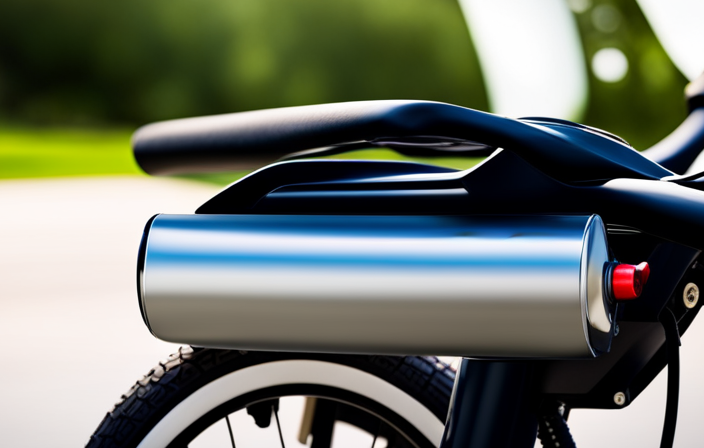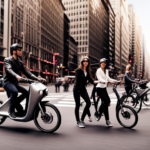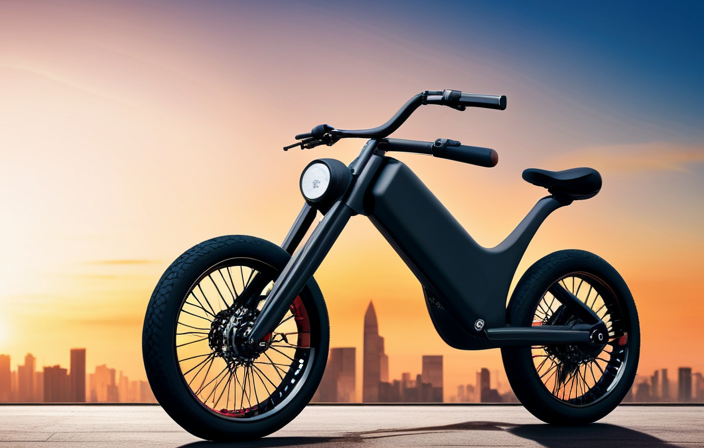I recently discovered the exciting world of electric bikes, and it’s clear that they are making a big impact in the cycling community. Their modern design and environmentally friendly features are making them a popular choice over traditional bicycles.
But what exactly is an electric bike, and how does it work? In this article, we will delve into the ins and outs of electric bikes, exploring their components, different types, and the countless benefits they offer.
So, hop on and let’s explore the electric bike revolution together!
Key Takeaways
- Electric bikes are experiencing rapid growth in the market and are becoming increasingly popular as an eco-friendly mode of transportation.
- Electric bikes offer convenience and ease of use, providing an alternative to traditional bicycles.
- There are various types of electric bikes available, including city e-bikes, mountain e-bikes, folding e-bikes, cargo e-bikes, and fat-tire e-bikes.
- Electric bikes work through a pedal-assist system and throttle control, with the battery powering the electric motor and providing assistance while pedaling. They can be charged using a standard electrical outlet and offer benefits such as health benefits, cost-effectiveness, reduced carbon footprint, and accessibility.
Introduction: The Rise of Electric Bikes
If you’re looking for a convenient and eco-friendly mode of transportation, electric bikes are becoming increasingly popular. The electric bike market has experienced significant growth in recent years, with more and more people opting for this alternative form of transportation.
The impact of electric bikes on transportation is undeniable. They offer a greener and more sustainable option for commuting, reducing the carbon footprint and helping to combat air pollution.
Electric bikes are not only environmentally friendly, but they also provide a practical solution for urban transportation. With the ability to easily maneuver through traffic and the added benefit of pedal-assist, electric bikes make commuting to work or running errands a breeze.
So, what is an electric bike? Let’s dive into the details in the next section.
What is an Electric Bike?
Imagine cruising effortlessly on a two-wheeled vehicle powered by a motor, reaching impressive speeds. That’s the beauty of an electric bike. Also known as e-bikes, they have an integrated electric motor that provides assistance to the rider, making pedaling easier and allowing for faster speeds.
One of the biggest advantages of electric bikes is their eco-friendliness. They emit zero emissions and reduce our carbon footprint. Additionally, e-bikes can be a great alternative to cars, saving money on fuel and reducing traffic congestion.
In terms of maintenance, electric bikes require regular checking of the battery, motor, and electrical components. It’s also important to keep the bike clean and lubricate the chain.
With all these advantages and a little maintenance, electric bikes can be a convenient and sustainable mode of transportation.
Moving on to the next section about the definition and components of electric bikes…
a. Definition and Components
The definition and components of an e-bike involve an integrated electric motor that assists the rider and allows for faster speeds.
An electric bike typically consists of four main components: the motor, the battery, the controller, and the sensor.
The motor is responsible for providing the additional power to the bike, allowing the rider to pedal with less effort.
The battery provides the energy needed to power the motor and is usually rechargeable.
The controller manages the flow of electricity between the battery and the motor, ensuring smooth operation.
Lastly, the sensor detects the rider’s pedaling and activates the motor accordingly.
These components work together seamlessly to create a smooth and efficient riding experience.
Now, let’s move on to the different types of electric bikes, such as city bikes and mountain bikes.
b. Types of Electric Bikes (e.g., city bikes, mountain bikes)
You can choose between different types of e-bikes, like city bikes and mountain bikes.
City bikes are designed for urban commuting and are typically lightweight, with a comfortable upright riding position. They often come with features like fenders, racks, and lights, making them perfect for running errands or commuting to work.
Mountain bikes, on the other hand, are built for off-road adventures. They have rugged frames, suspension systems, and knobby tires for tackling rough terrains. Some electric mountain bikes even come with a throttle mode, allowing you to ride effortlessly up steep hills.
Another popular type is the folding bike, which offers convenience and portability. These bikes can be easily folded and stored, making them a great choice for commuters or those with limited storage space.
Now, let’s dive into how electric bikes work and what makes them so unique.
How Do Electric Bikes Work?
Electric bikes work by using a battery-powered motor to assist the rider’s pedaling. This technology has revolutionized the way we commute and enjoy biking. The electric motor provides an extra boost, making it easier to pedal uphill or against strong winds. The battery is typically rechargeable and powers the motor, allowing for longer rides without getting tired.
One of the main advantages of electric bikes is that they are eco-friendly, producing zero emissions and reducing our carbon footprint. They also offer a more convenient and efficient way to travel, especially in congested city areas. Electric bikes are a great option for people who want to commute to work or run errands without breaking a sweat.
In the next section, we will explore the components that make electric bikes work, such as the electric motor and battery.
a. Electric Motor and Battery
When it comes to electric bikes, understanding how they work is crucial. In the previous subtopic, we discussed the basics of electric bike functionality. Now, let’s dive deeper into the electric motor and battery, the two key components that make these bikes run.
-
Electric Motor: The heart of an electric bike, the motor converts electrical energy from the battery into mechanical energy to propel the bike forward. Electric motors vary in power and efficiency, with brushless motors being the most common and efficient type used in modern electric bikes.
-
Battery: The battery is the powerhouse that provides the electrical energy to the motor. Battery life optimization is crucial for maximizing the bike’s range. Factors like battery capacity, chemistry, and management systems play a vital role in determining how long the bike can travel on a single charge.
-
Electric Motor Efficiency: Optimizing the electric motor’s efficiency ensures that the bike’s energy consumption is minimized, allowing for longer rides and increased overall performance.
-
Battery Life Optimization: Implementing strategies to extend the battery’s life, such as proper charging practices and avoiding extreme temperatures, helps maintain its capacity over time.
Now, let’s explore another critical aspect of electric bikes: ‘b. pedal assist vs. throttle control.’
b. Pedal Assist vs. Throttle Control
Get ready to explore the difference between pedal assist and throttle control on an e-bike. When it comes to electric bikes, there are two main ways to control the motor: pedal assist and throttle control. Pedal assist, also known as pedal-assist electric bikes (or e-bikes), provide assistance when you pedal, making it feel like you have superhuman strength. Throttle control, on the other hand, allows you to control the motor with a twist grip or a button, similar to a motorcycle.
To understand the difference between the two, let’s take a look at this table:
| Pedal Assist | Throttle Control | |
|---|---|---|
| Control | Pedal | Twist grip/button |
| Safety | More control | Less control |
| Maintenance | Less wear | More wear |
| Financing | Incentives | No incentives |
When it comes to safety considerations, pedal assist provides more control since the motor only engages when you pedal. This can be especially useful when navigating steep inclines or tricky terrain. In terms of maintenance and care, pedal assist tends to result in less wear and tear on the bike’s components compared to throttle control. Additionally, some areas offer financing options and incentives for purchasing pedal assist e-bikes, making them a more affordable option.
As we delve into the benefits of riding an electric bike, you’ll see how pedal assist and throttle control play a role in enhancing your overall riding experience.
Benefits of Riding an Electric Bike
Experience the numerous advantages of riding an e-bike. Electric bikes provide increased convenience and a reduced carbon footprint. They also offer a range of health benefits, making them an excellent choice for commuting. When riding an e-bike, you still get the benefit of physical exercise, but with the added assistance of an electric motor. This means that you can choose the level of exertion that suits your fitness level or desired workout intensity.
Plus, the pedal assist feature allows you to tackle hills and longer distances with ease, reducing the strain on your muscles and joints. Riding an electric bike is also a great way to reduce your carbon footprint and contribute to a cleaner environment.
With all these benefits in mind, it’s clear that riding an e-bike is a smart and sustainable choice for your daily commute and overall well-being.
Transitioning into the next section, let’s explore the specific health and fitness benefits of riding an electric bike.
a. Health and Fitness Benefits
Improve your overall health and fitness by riding an e-bike, enjoying the benefits of increased convenience and reduced carbon footprint. Electric bikes offer numerous health benefits and fitness advantages that make them an excellent choice for individuals of all fitness levels. Firstly, riding an e-bike provides a low impact aerobic exercise that helps strengthen your cardiovascular system and burns calories. It is a great way to improve your stamina, endurance, and muscle tone, especially in the legs and core. Secondly, electric bikes make it easier for people with physical limitations or health conditions to engage in physical activity. The pedal-assist feature allows you to control the level of assistance you need, making it possible to gradually increase your fitness level. Lastly, incorporating regular e-bike rides into your routine can help reduce stress and improve mental well-being. Transitioning into the next section, let’s explore the environmental benefits of riding an electric bike.
b. Environmental Benefits
By riding an e-bike, you can contribute to a greener environment and reduce your carbon footprint. Electric bike adoption has a positive impact on air quality by reducing the emissions of greenhouse gases and pollutants that contribute to climate change and poor air quality.
Here are some ways in which e-bikes help the environment:
- Electric bikes produce zero emissions, making them an eco-friendly mode of transportation.
- By replacing car trips with e-bike rides, you can reduce the amount of air pollution in your community.
- E-bikes require less energy to operate compared to cars, thus reducing the overall demand for fossil fuels.
- Electric bikes also help alleviate traffic congestion, leading to smoother flow and reduced idling emissions.
By choosing to ride an e-bike, you are actively participating in creating a cleaner and healthier environment. Riding an e-bike not only benefits you personally but also has a positive impact on the world around you.
Transitioning to the next section, let’s explore the cost savings associated with using electric bikes.
c. Cost Savings
Save money by using an e-bike for transportation. Not only are electric bikes a more environmentally friendly option, but they also provide significant cost savings.
When considering the cost analysis, it’s important to look at the return on investment. While the initial purchase price of an e-bike may be higher than a traditional bicycle, the long-term savings make it a worthwhile investment. With an e-bike, you can save on fuel costs, parking fees, and public transportation expenses. Additionally, the maintenance costs for an electric bike are relatively low compared to a car or motorcycle.
By choosing an e-bike, you can enjoy the benefits of cost savings while reducing your carbon footprint and contributing to a cleaner environment.
Transitioning into the next section about convenience and accessibility, e-bikes offer even more advantages for everyday transportation needs.
d. Convenience and Accessibility
Enjoy the convenience and accessibility of using an e-bike for your everyday transportation needs. With various convenience options available, such as built-in storage compartments and adjustable seats, e-bikes provide a hassle-free commuting experience. Additionally, their compact size allows for easy navigation through crowded streets and limited parking spaces. However, it is important to acknowledge the accessibility challenges that some individuals may face. While e-bikes offer an alternative mode of transportation for many, those with physical disabilities or limited mobility may still encounter obstacles. To address this, manufacturers are continuously working on designing e-bikes with improved accessibility features, such as step-through frames and adjustable handlebars. These advancements aim to make e-bikes more inclusive and accessible to a wider range of individuals. Transitioning into the subsequent section about ‘choosing the right electric bike,’ it is crucial to consider not only convenience and accessibility but also other factors such as battery life and motor power.
Choosing the Right Electric Bike
To choose the right e-bike for you, consider factors such as your preferred riding style, desired range, and budget.
When it comes to motor power, you’ll want to think about how much assistance you need. Higher wattage motors provide more power, making them suitable for off-road adventures or hilly terrains. However, if you plan on using your e-bike mainly for urban commuting or leisurely rides, a lower wattage motor may suffice.
Battery range is another crucial aspect to consider. Determine how far you typically ride and choose a bike with a battery that can accommodate your needs. Keep in mind that battery range can vary depending on factors like terrain and riding conditions.
Considering your riding needs and preferences, let’s explore the different types of e-bikes available.
a. Consider Your Riding Needs and Preferences
When considering your riding needs and preferences, it’s important to think about factors such as your preferred riding style, desired range, and budget.
If you’re on a tight budget, it’s a good idea to compare the features of different electric bikes to find the best value for your money. Look for bikes that offer the features you need without breaking the bank.
On the other hand, if you have a larger budget, you may have more options to choose from. Take into account your preferred riding style, whether you enjoy long rides or prefer shorter commutes. Additionally, consider the desired range of the electric bike, as this will determine how far you can travel on a single charge.
Understanding these factors will help you make an informed decision when it comes to choosing the right electric bike.
Transitioning into the next section about understanding motor power and battery range, it’s important to delve deeper into the technical aspects of electric bikes.
b. Understanding Motor Power and Battery Range
Consider your preferred riding style and how far you want to travel on a single charge, as this will help you understand the motor power and battery range that would be suitable for you. When it comes to electric bikes, motor power and battery life are crucial factors to consider.
The motor power determines the bike’s speed and ability to tackle different terrains. Higher power motors are ideal for off-road adventures or hilly areas, while lower power motors are suitable for casual city rides.
On the other hand, battery range refers to how far the bike can travel on a single charge. Factors affecting battery range include terrain, rider weight, wind resistance, and assistance level. It is important to choose a bike with a battery range that aligns with your intended use.
Now that you have a better understanding of motor power and battery range, it’s time to move on to testing and comparing different models.
c. Testing and Comparing Different Models
Testing and comparing different models can help you determine the best option for your preferred riding style and desired range.
When it comes to testing electric bikes, there are a few important factors to consider. One method is to test the motor power and battery range. This involves evaluating the performance of the motor under different conditions, such as uphill climbs and varying terrain. It also involves measuring the distance the bike can travel on a single charge. By comparing these factors across different models, you can get a better understanding of their capabilities and limitations.
Additionally, performance evaluation should include factors like acceleration, top speed, and overall handling. This will give you a comprehensive view of how each model performs in real-world situations.
Moving forward, let’s discuss some safety tips for riding an electric bike, ensuring a smooth and enjoyable experience.
Safety Tips for Riding an Electric Bike
To ensure a smooth and enjoyable ride, it’s important to follow these safety tips when riding your e-bike.
-
Regular bike maintenance: Keep your electric bike in good working condition by checking the brakes, tires, and battery before each ride.
-
Wear the right gear: Always wear a helmet to protect your head in case of a fall. Additionally, wear bright colored clothing to increase visibility to other road users.
-
Follow traffic laws: Obey all traffic laws and regulations, including stopping at red lights and yielding to pedestrians.
-
Be aware of your surroundings: Stay alert and constantly scan the road for potential hazards. Use rearview mirrors if available.
-
Ride defensively: Assume that other road users may not see you and be prepared to take evasive action if necessary.
By practicing these safety tips, you can enjoy a safe and secure ride on your electric bike.
Moving forward to the next section about obeying traffic laws and regulations, it is essential to stay informed about the rules of the road.
a. Obey Traffic Laws and Regulations
Now that we’ve covered some important safety tips for riding an electric bike, let’s dive into the first one: obeying traffic laws and regulations.
It is crucial to treat your electric bike just like any other vehicle on the road. This means following all the traffic signals, signs, and rules of the road. Always ride in the designated bike lanes, if available, and signal your turns to alert other road users. By obeying traffic laws, you not only ensure your own safety but also contribute to the overall flow and harmony of traffic.
Additionally, it is essential to take safety precautions such as wearing a helmet, using lights at night, and being aware of your surroundings. These measures will greatly enhance your riding experience and keep you safe on the road.
Speaking of safety precautions, let’s move on to the next section about wearing protective gear.
b. Wear Protective Gear
Don’t forget to wear your protective gear to ensure your safety while riding. Electric bike safety is of utmost importance, and wearing the right gear can greatly reduce the risk of injuries.
When riding an electric bike, it is crucial to wear a helmet that fits properly and protects your head in case of any accidents. Additionally, wearing knee and elbow pads, as well as gloves, can provide extra protection to your body. These gears can prevent serious injuries, such as concussions, broken bones, and road rash.
By wearing protective gear, you can confidently ride your electric bike knowing that you have taken the necessary precautions to keep yourself safe.
As we move on to the next section about being aware of your surroundings, remember that staying alert is equally important in ensuring a safe and enjoyable ride.
c. Be Aware of Your Surroundings
Stay vigilant and observe your surroundings while riding, ensuring a safe and enjoyable experience. Bike safety is of utmost importance, and one way to ensure it is by practicing situational awareness. Here are some key points to keep in mind:
- Always scan your surroundings: Regularly check your mirrors and glance over your shoulder to be aware of any approaching vehicles or obstacles.
- Anticipate potential risks: Stay alert for pedestrians, other cyclists, or sudden changes in traffic patterns.
- Maintain a safe distance: Keep a buffer zone between you and other vehicles to allow for sudden stops or changes in direction.
- Use your senses: Listen for approaching vehicles, and use your peripheral vision to detect movement in your surroundings.
By following these guidelines, you can enhance your bike safety and enjoy a worry-free ride.
With that in mind, it’s essential to regularly maintain and inspect your bike to ensure optimal performance and safety.
d. Regularly Maintain and Inspect Your Bike
Make sure to regularly check and maintain your bicycle to ensure it is in optimal condition for safe riding. Proper maintenance is crucial for the longevity and performance of your electric bike.
Here are a few maintenance tips to keep in mind. Firstly, regularly clean your bike to prevent dirt and debris build-up. This will help extend the lifespan of your components.
Secondly, check your tire pressure regularly and ensure it is within the recommended range for optimal performance. Additionally, inspect your brakes, chain, and gears for any signs of wear and tear, and make necessary adjustments or replacements.
Lastly, familiarize yourself with a troubleshooting guide specific to your electric bike model. This will help you identify and resolve any minor issues that may arise.
By following these maintenance tips, you can keep your electric bike in excellent condition for a safe and enjoyable ride.
Now, let’s dive into the top electric bike brands and models.
Top Electric Bike Brands and Models
One of the top brands for electric bikes is Rad Power Bikes, known for their high-quality models. They offer a wide range of electric bikes that cater to different needs and preferences.
One popular model from Rad Power Bikes is the RadRover, which is a versatile and powerful electric bike designed for off-road adventures. It features fat tires, a powerful motor, and a long-lasting battery, making it perfect for tackling any terrain.
Another popular model is the RadCity, which is a sleek and stylish electric bike designed for urban commuting. It offers a comfortable ride, excellent range, and various convenient features like integrated lights and a rear rack.
These are just a few examples of the top electric bike brands and models available on the market. Moving on to an overview of popular brands…
a. Overview of Popular Brands
Now that we’ve explored the top electric bike brands, let’s take a closer look at some of the most popular ones.
These brands have gained recognition for their quality products and reliable performance. In this section, I will provide an overview of these popular brands and highlight their pros and cons.
- Bosch: Known for its powerful motors and long battery life.
- Yamaha: Offers a range of models with excellent speed and acceleration.
- Shimano: Provides smooth and precise shifting, ideal for mountain biking.
- Giant: Offers a wide variety of electric bikes at affordable prices.
- Specialized: Known for its innovative designs and high-performance features.
Each brand has its own unique strengths and weaknesses, so it’s important to consider your specific needs and preferences when choosing an electric bike.
Now, let’s move on to the next section, where we will highlight notable models and their features.
b. Highlighting Notable Models and Features
Moving on to the next section, let’s take a look at some notable models and their key features.
When it comes to electric bikes, there are several models that stand out from the crowd. One notable model is the RadRover by Rad Power Bikes. It features a powerful motor, a long-lasting battery, and fat tires for superior traction.
Another option to consider is the Super73 S1. This stylish bike not only looks great, but it also has a top speed of 20 mph and a range of up to 40 miles.
For those who prefer a folding electric bike, the Brompton Electric is a fantastic choice. It offers a compact design, a lightweight frame, and a smooth ride.
These notable models showcase the diverse range of options available in the electric bike market.
Now, let’s move on to explore electric bike accessories and upgrades, which can enhance your riding experience even further.
Electric Bike Accessories and Upgrades
To enhance your riding experience even further, you can consider adding accessories and upgrades to your electric bike. Here are three popular electric bike accessories that can take your rides to the next level:
-
Bike Lights: Ensure your safety and visibility on the road by adding high-quality lights to your electric bike. LED lights are energy-efficient and provide excellent illumination, making it easier for you to navigate during low-light conditions.
-
Rear Rack: Installing a rear rack on your electric bike provides extra storage space for carrying essentials such as a backpack, groceries, or even a picnic basket. It’s a convenient upgrade that allows you to transport items without the need for a separate bag or basket.
-
Suspension Seatpost: Electric bikes often have sturdy frames, but a suspension seatpost can provide additional comfort during bumpy rides. This upgrade absorbs shocks and vibrations, reducing strain on your body and making longer rides more enjoyable.
By adding these accessories, you can improve not only your riding experience but also the overall maintenance of your electric bike.
Now let’s move on to the essential accessories like helmets and locks.
a. Essential Accessories (e.g., helmet, lock)
One of the most important essential accessories for riding is a helmet. It is crucial to prioritize safety and protect your head in case of any falls or accidents. When choosing the right electric bike, there are several other essential accessories that you should consider. These accessories can enhance your riding experience and provide added convenience. To help you make an informed decision, here is a table highlighting some essential accessories for electric bikes:
| Accessory | Description |
|---|---|
| Helmet | Protects your head from potential injuries |
| Lock | Secures your bike and prevents theft |
| Lights | Ensures visibility and safety during night rides |
| Bell | Alerts pedestrians and other cyclists of your presence |
| Fenders | Keeps you clean and dry by preventing splashes |
Now that we have covered the essential accessories, let’s move on to optional upgrades such as lights and cargo racks.
b. Optional Upgrades (e.g., lights, cargo racks)
When it comes to electric bikes, there are not only essential accessories that should be considered, but also optional upgrades that can greatly enhance your riding experience.
One of these upgrades is a cargo rack, which provides additional storage space for your belongings. Whether you need to transport groceries or carry your backpack, there are various cargo rack options available to suit your needs.
Additionally, upgrading the lighting system on your electric bike is a great way to improve safety and visibility, especially when riding at night or in low-light conditions. From powerful headlights to rear lights and turn signals, there are plenty of lighting upgrades to choose from.
These upgrades not only make your electric bike more functional and practical but also ensure that you ride safely and confidently.
Now, let’s move on to the next section and discuss electric bike etiquette and considerations.
Electric Bike Etiquette and Considerations
Considerations to keep in mind while riding an e-bike include being aware of your surroundings and practicing good etiquette on the road. Electric bike safety should always be a top priority, and this includes wearing a helmet, obeying traffic laws, and using hand signals when turning. Additionally, regular electric bike maintenance is essential for optimal performance and longevity. This includes checking tire pressure, inspecting the brakes, and keeping the battery charged. To help you remember these important considerations, here is a handy table:
| Electric Bike Safety | Electric Bike Maintenance |
|---|---|
| Wear a helmet | Check tire pressure |
| Obey traffic laws | Inspect brakes |
| Use hand signals | Keep battery charged |
By following these guidelines, you can ensure a safe and enjoyable ride on your electric bike. Now let’s transition to the next section about sharing paths and trails with pedestrians.
a. Sharing Paths and Trails with Pedestrians
To safely share paths and trails with pedestrians, it’s important to be mindful of your surroundings and practice good etiquette. Here are some safety precautions to consider:
- Slow down: When approaching pedestrians, reduce your speed to avoid startling or colliding with them.
- Announce your presence: Use a bell or call out a friendly warning to let pedestrians know you’re approaching from behind.
- Give space: When passing pedestrians, leave enough room for them to feel comfortable and safe.
By following these guidelines, you can ensure a pleasant and safe experience for both you and pedestrians. It’s crucial to be respectful and considerate when sharing paths and trails.
Next, let’s discuss how to interact with other cyclists and vehicles without compromising safety or enjoyment.
b. Interacting with Other Cyclists and Vehicles
To safely interact with other cyclists and vehicles, it’s important to be aware of your surroundings and follow traffic rules. When sharing the road with cars, always ride in the same direction as traffic and use hand signals to indicate your intentions. Keep a safe distance from cars, especially when they are turning or changing lanes. Remember to be patient and respectful towards other cyclists, giving them enough space to pass and signaling before overtaking.
Interacting with pedestrians requires even more caution. Slow down when approaching pedestrians, give them the right of way, and always announce your presence with a bell or a polite verbal warning.
Being aware of your surroundings and showing courtesy to others will ensure a safe and enjoyable experience on your electric bike.
This leads us to the next topic of properly parking and storing your electric bike.
c. Properly Parking and Storing Your Electric Bike
When parking and storing your e-bike, make sure to find a secure location that is well-lit and easily accessible. Properly parking and storing your electric bike is essential to ensure its safety and longevity. Here are some important tips to consider:
- Invest in a sturdy bike lock to deter thieves.
- Look for designated bike parking areas or racks in public spaces.
- Consider using a wall-mounted bike rack or a bike storage solution at home.
- Keep your e-bike indoors whenever possible to protect it from the elements.
- Regularly inspect and maintain your bike’s tires, brakes, and battery to prevent any issues.
By following these guidelines, you can have peace of mind knowing that your electric bike is well-protected.
Now, let’s explore the exciting future trends and innovations in electric bikes.
Future Trends and Innovations in Electric Bikes
One exciting future trend in e-bikes is the development of advanced battery technology for longer-lasting rides. As technology continues to advance, e-bike manufacturers are investing in smart features that enhance the overall riding experience. For example, some electric bikes now come equipped with GPS tracking, allowing riders to easily locate their bikes if they are stolen or misplaced. Additionally, electric bike sharing programs are becoming more popular, providing a convenient and eco-friendly transportation option in urban areas. These programs typically utilize advanced technology to manage bike rentals and ensure a seamless user experience. With the combination of smart features and electric bike sharing, the future of e-bikes is set to revolutionize urban transportation. Transitioning into the subsequent section about advances in battery technology, it is clear that the development of longer-lasting batteries will further enhance the capabilities of electric bikes.
a. Advances in Battery Technology
The development of advanced battery technology is revolutionizing the capabilities of e-bikes. With continuous advancements in battery technology, electric bikes are becoming more powerful and efficient than ever before.
These advancements have a significant impact on transportation, as e-bikes can now travel longer distances and tackle challenging terrains with ease. The latest lithium-ion batteries offer higher energy density, longer lifespan, and quicker charging times. This means that riders can enjoy longer rides without worrying about running out of power.
Additionally, these advancements in battery technology have allowed for the integration of smart features, such as smartphone connectivity and GPS tracking, enhancing the overall riding experience. The integration of smart features further enhances the convenience and functionality of e-bikes, making them an attractive alternative to traditional bikes.
b. Integration of Smart Features
With the integration of smart features, e-bikes are becoming more convenient and functional. Smart features in electric bikes include things like GPS navigation, Bluetooth connectivity, and smartphone integration. These features allow riders to easily track their routes, monitor their speed and distance, and even receive notifications on their phone.
However, integrating these smart features into electric bikes does come with its challenges. One of the main challenges is ensuring that the technology is seamlessly integrated into the bike without adding too much weight or compromising the overall design. Another challenge is making sure that the smart features are intuitive and easy to use, so that riders can fully enjoy the benefits without any hassle.
Despite these challenges, the integration of smart features is a major step forward in making electric bikes more user-friendly and accessible. This leads us to the next section about the growth of electric bike sharing programs, which further highlights the increasing popularity and demand for electric bikes.
c. Growth of Electric Bike Sharing Programs
Now let’s shift our focus to another exciting development in the electric bike industry: the growth of electric bike sharing programs. These programs have gained popularity in recent years and have seen significant growth trends. Electric bike sharing programs allow people to rent electric bikes for short periods of time, providing a convenient and eco-friendly mode of transportation in urban areas. These programs have not only contributed to reducing traffic congestion and air pollution but have also had a positive economic impact. They have created job opportunities, boosted local economies, and increased tourism. As more cities and communities embrace electric bike sharing programs, we can expect to see further growth and expansion in the future. Now, let’s move on to the next section where we will discuss maintenance and care for your electric bike.
Maintenance and Care for Your Electric Bike
When it comes to keeping your e-bike in good condition, regular maintenance is key to ensure optimal performance. To help you maintain your electric bike, here are some maintenance tips and a troubleshooting guide.
First, make sure to regularly check the tire pressure and adjust it as needed to improve the bike’s handling and efficiency. Additionally, keep an eye on the brake pads and replace them if they become worn out.
It’s also important to clean and lubricate the chain regularly to prevent rust and ensure smooth operation. If you encounter any issues, such as a loss of power or strange noises, consult the troubleshooting guide provided by the manufacturer.
By following these maintenance steps, you can keep your electric bike running smoothly and prolong its lifespan.
Moving on to the next section about cleaning and lubricating…
a. Cleaning and Lubricating
To keep your e-bike in top shape, it’s important to regularly clean and lubricate its components.
Cleaning your electric bike is crucial to remove dirt, grime, and debris that can build up over time. Start by using a soft cloth or sponge and mild soap to gently wipe down the frame, wheels, and other parts. Pay extra attention to the chain, gears, and brakes, as these areas tend to accumulate the most dirt.
It’s also essential to lubricate your e-bike regularly to ensure smooth operation. Use a high-quality lubricant specifically designed for bicycles and apply it to the chain, derailleurs, and other moving parts. This will help reduce friction and extend the lifespan of your e-bike’s components. Some recommended lubricants include WD-40 Bike Chain Lube and Finish Line Wet Bicycle Lubricant.
Moving on to battery maintenance and charging…
b. Battery Maintenance and Charging
Make sure you regularly maintain and charge your e-bike’s battery to optimize its performance.
Battery maintenance is crucial to ensure the longevity and efficiency of your electric bike. Firstly, it is important to keep the battery clean and free from dirt and debris. Use a soft cloth to wipe it down regularly, avoiding any harsh chemicals that may damage the battery.
Additionally, check the battery’s connections to ensure they are secure and free from corrosion.
When it comes to charging, follow the manufacturer’s guidelines for the recommended charging techniques. Avoid overcharging the battery, as this can shorten its lifespan. It is also advisable to charge the battery after each ride, even if it is not completely depleted.
By following these battery maintenance and charging techniques, you can ensure your e-bike is always ready to hit the road.
Now, let’s move on to troubleshooting common issues without wasting any time.
c. Troubleshooting Common Issues
One way to address common issues with your e-bike is by troubleshooting them. Here are some troubleshooting tips to help you identify and fix common problems:
-
Battery not charging:
-
Check the power source and make sure it’s working.
-
Inspect the charging cable for any damages.
-
Restart the charging process by unplugging and plugging it back in.
-
Motor not working:
-
Check the connection between the motor and the controller.
-
Examine the motor for any loose wires or damaged parts.
-
Reset the system by turning off the bike and turning it back on.
-
Display not functioning:
-
Ensure the display is properly connected.
-
Check the battery level and charge if necessary.
-
Reset the display by holding the power button for a few seconds.
By following these troubleshooting tips, you can easily resolve common issues with your e-bike.
Now let’s delve into the financing and cost considerations for purchasing an electric bike.
Financing and Cost Considerations
Financing an e-bike can be a significant investment, so it’s important to carefully consider the cost and payment options. When it comes to financing options, there are a few routes you can take. Some electric bike manufacturers offer their own financing plans, allowing you to make monthly payments over a set period of time. Alternatively, you could consider applying for a personal loan from a bank or credit union. This option may give you more flexibility in terms of repayment terms and interest rates. Budget considerations are also important when financing an electric bike. Take into account your monthly income, expenses, and any other financial commitments you have. It’s crucial to ensure that the monthly payments fit comfortably within your budget.
| Financing Options | Pros | Cons |
|---|---|---|
| Manufacturer financing | Convenient, may offer lower interest rates | Limited to specific brands, may have strict eligibility criteria |
| Personal loan | More flexibility, can choose any brand | Higher interest rates, may require good credit score |
Considering these financing options and your budget, you can determine the most suitable way to finance your electric bike purchase. Moving on to the next section about the price range of electric bikes, it’s important to understand how much you can expect to spend.
a. Price Range of Electric Bikes
The cost of an e-bike can vary significantly depending on the brand and features. There are many electric bike brands out there, each with their own pricing structure. Some well-known brands, like Rad Power Bikes and Trek, offer a range of models at different price points, starting from around $1,000 and going up to $5,000 or more.
The price of an electric bike is often influenced by the features it offers, such as motor power, battery capacity, and the quality of components. Higher-end models tend to have more advanced features and may come with additional accessories like lights, fenders, and racks. It’s important to consider your budget and needs when choosing an electric bike.
Moving on to financing options and incentives, there are various ways to make owning an e-bike more affordable.
b. Financing Options and Incentives
Consider exploring financing options and incentives to make owning an e-bike more affordable for you. Here are four ways to save on your electric bike purchase:
-
Financing Plans: Many bike shops and manufacturers offer financing options with low or no interest rates. This allows you to spread out the cost of your e-bike over several months or years, making it easier on your budget.
-
Government Incentives: Some countries and regions offer incentives for purchasing electric bikes. These can include tax credits, rebates, or grants. Check with your local government to see if there are any programs that can help offset the cost of your e-bike.
-
Manufacturer Discounts: Keep an eye out for special promotions and discounts offered by e-bike manufacturers. They often have sales events or clearance deals that can save you a significant amount of money.
-
Trade-In Programs: If you already own a traditional bike, some bike shops offer trade-in programs where you can exchange it for credit towards an e-bike. This can help reduce the overall cost of your new electric bike.
By taking advantage of these financing options and incentives, you can make owning an e-bike more affordable. Now let’s delve into the next section about the long-term cost comparison with traditional bikes.
c. Long-Term Cost Comparison with Traditional Bikes
To determine the long-term cost comparison between traditional bikes and e-bikes, you’ll need to factor in maintenance, fuel, and repair expenses. When it comes to long-term maintenance, e-bikes have an advantage over traditional bikes. Electric bikes typically require less maintenance since they have fewer moving parts and no need for oil changes or tune-ups. Additionally, the cost of replacement parts for e-bikes tends to be lower compared to traditional bikes. This is because e-bike components are often standardized and readily available.
To illustrate this point, here is a comparison table:
| Cost Factors | Traditional Bikes | E-Bikes |
|---|---|---|
| Maintenance | Higher | Lower |
| Fuel Expenses | None | Lower |
| Repair Expenses | Variable | Lower |
With lower long-term maintenance costs and reduced expenses for fuel and repairs, e-bikes prove to be a cost-effective alternative to traditional bikes. Moving on to the next section about testimonials and success stories, you’ll get a better understanding of the real-life experiences of e-bike users.
Testimonials and Success Stories
Check out what other riders have to say about their experiences with e-bikes and hear their success stories.
Many people have found that electric bikes have greatly improved their daily commute and overall lifestyle. Testimonials show that e-bike users appreciate the convenience and ease of riding, especially when tackling hills or long distances.
One rider mentioned how their electric bike allowed them to effortlessly travel to work without breaking a sweat, while another shared how they were able to explore new areas and enjoy the outdoors more often. Success stories also highlight the cost savings of owning an e-bike, as it eliminates the need for gas or parking fees.
Overall, these testimonials and success stories demonstrate the numerous benefits and positive impact that electric bikes have on people’s lives. Transitioning into the subsequent section about ‘a. real-life experiences and benefits shared by electric bike users’, it’s clear that e-bikes offer a transformative and enjoyable riding experience.
a. Real-Life Experiences and Benefits Shared by Electric Bike Users
Users of e-bikes have shared their real-life experiences and the many benefits they have enjoyed, showcasing the transformative and enjoyable nature of these rides.
One common experience shared by electric bike users is the sense of freedom and convenience they provide. With the assistance of the electric motor, riders can effortlessly conquer hills and cover longer distances without breaking a sweat.
Additionally, e-bikes offer a more eco-friendly alternative to traditional vehicles, reducing carbon emissions and helping to combat air pollution. Many users have also highlighted the health benefits of electric biking, as it provides a low-impact form of exercise that can improve cardiovascular health and strengthen muscles.
Moreover, electric bikes allow riders to avoid traffic congestion, saving time and reducing stress.
Now, let’s address some frequently asked questions (FAQs) about electric bikes.
Frequently Asked Questions (FAQs)
One common question people have is whether e-bikes are allowed on bike paths and trails. The answer to this question varies depending on the specific rules and regulations in your area.
In general, electric bikes are allowed on most bike paths and trails as long as they meet certain criteria. For example, the maximum speed of the e-bike may be limited, typically to around 20 mph, and the motor may need to be under a certain wattage. It’s important to familiarize yourself with your local laws and regulations regarding e-bike usage to ensure that you are riding safely and legally.
In terms of maintenance, electric bikes require regular upkeep, just like any other bike. This includes checking the tires, brakes, and chain, as well as keeping the battery charged and clean. Taking proper care of your e-bike will help ensure its longevity and performance.
Now let’s address some common inquiries about electric bikes.
a. Common Inquiries about Electric Bikes
Let’s address some frequently asked questions about e-bikes.
One common misconception about electric bikes is that they are not regulated like traditional bicycles. However, safety regulations for e-bikes do exist. In most countries, e-bikes are classified as bicycles as long as they meet certain criteria such as maximum speed and power limits.
Another misconception is that e-bikes are dangerous to ride. In reality, e-bikes are designed with safety in mind, and when operated responsibly, they can be just as safe as regular bicycles. It’s important to wear a helmet, follow traffic laws, and be aware of your surroundings while riding.
Embracing the electric bike revolution allows us to experience the benefits of a greener mode of transportation. So, let’s explore the reasons why e-bikes are gaining popularity.
Conclusion: Embracing the Electric Bike Revolution
In conclusion, embracing the e-bike revolution allows us to enjoy the benefits of a more sustainable and efficient mode of transportation. Electric bikes offer numerous advantages for commuting, making them a viable and attractive option for urban transportation.
One of the key advantages of electric bike commuting is the reduced environmental impact. By using electric bikes instead of cars or motorcycles, we can significantly decrease carbon emissions and air pollution. This not only improves the air quality in our cities but also helps combat climate change.
Moreover, electric bikes offer a cost-effective alternative to traditional transportation methods. They require less maintenance and have lower operating costs compared to cars or motorcycles. Additionally, the convenience of electric bikes, such as their ability to navigate through traffic and find parking easily, makes commuting in congested urban areas much more efficient and time-saving.
Incorporating electric bikes into our daily lives can bring about a positive change in our urban transportation systems. By reducing our reliance on fossil fuel-powered vehicles, we can create cleaner, greener, and more sustainable cities for future generations. So let’s embrace the electric bike revolution and contribute to a better and brighter future.
| Advantages of Electric Bike Commuting | Impact of Electric Bikes on Urban Transportation |
|---|---|
| Reduced environmental impact | Decreased carbon emissions and air pollution |
| Cost-effective transportation | Lower maintenance and operating costs |
| Efficient and time-saving commuting | Improved traffic flow and parking convenience |
Frequently Asked Questions
Are electric bikes legal to ride on public roads and bike paths?
Yes, electric bikes are legal to ride on public roads and bike paths. Electric bike regulations vary by country and state, but generally they are allowed as long as they meet certain requirements. Using electric bikes has numerous benefits, such as reducing emissions and providing an easier commute.
How far can an electric bike travel on a single charge?
On a single charge, an electric bike can travel anywhere from 20 to 100 miles, depending on factors such as battery capacity, terrain, rider weight, and level of pedal assistance. How far will your adventures take you?
Can I ride an electric bike in the rain?
Yes, you can ride an electric bike in the rain. While it’s important to maintain and care for your electric bike, there are several benefits to riding in the rain, including increased traction and a refreshing experience.
Are electric bikes suitable for riders of all ages and fitness levels?
Electric bikes offer a wide range of benefits for riders of all ages and fitness levels. They provide a fun and enjoyable way to stay active, improve cardiovascular health, and increase overall fitness.
How long does it take to fully charge the battery of an electric bike?
It typically takes around 4-6 hours to fully charge an electric bike’s battery. The charging time may vary depending on the specific model and battery capacity. It’s important to note that battery life can also be affected by factors such as terrain and riding style.
Conclusion
After exploring the world of electric bikes, I am convinced that they are the future of transportation. The rise of electric bikes has revolutionized the way we travel, combining the convenience of a traditional bicycle with the power of electricity.
With various types available, such as city bikes and mountain bikes, there is an electric bike for everyone. The real-life experiences and benefits shared by electric bike users have only heightened my excitement for this mode of transportation.
So, if you’re ready to embrace the electric bike revolution, get ready for an electrifying ride like no other!
















